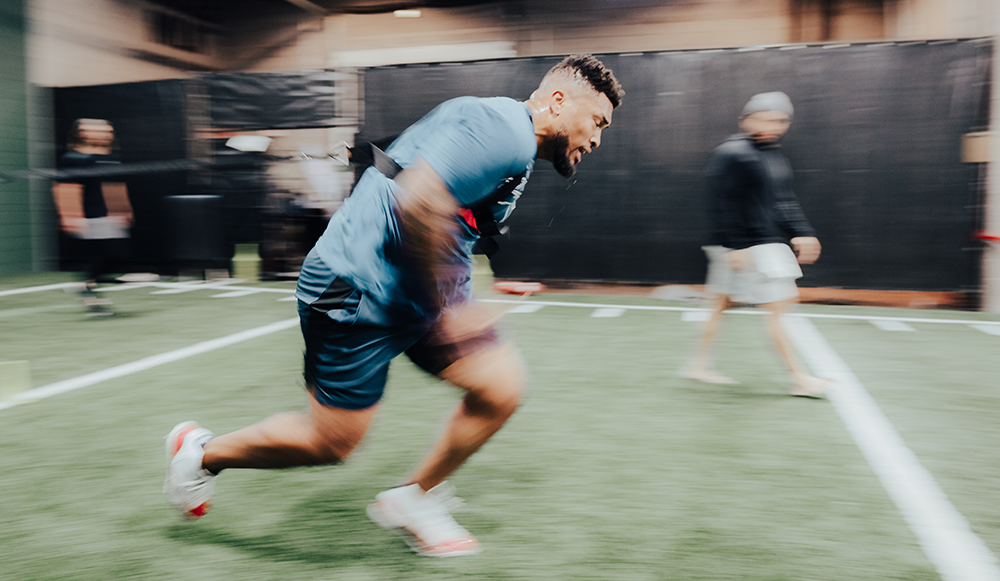Ever wonder what it takes for a pro to be football fit? Brett Fischer, PT, ATC, CSCS has worked closely with many professional athletes and NFL teams throughout his career to help them compete at their highest level. Today, he shares some of the secrets to being a top tier athlete.
1. Physicals
Make sure you are staying healthy. All NFL players receive and must pass an extensive physical. These in-depth exams include things such as X-rays, MRIs, electrocardiograms and much more.
All young athletes/weekend warriors should start off their seasons by getting a physical from their personal physicians. This exam should include an evaluation of the lungs, heart, blood pressure, medical history, vision, abdomen, genitals, musculoskeletal and nervous system.
The purpose of the physical is to avoid any catastrophic medical event and determine if it is safe to allow the athlete to participate in football. All of this plays into becoming football fit.
2. Basic Movement Screens
Many NFL players receive an in-depth movement analysis of their whole body. These screens can lead medical staff to prescribe specific corrective exercises to improve performance. The team at the Sports Institute will gladly help perform our athlete screen on any athlete— youth to professional — to help prescribe an ideal program to ensure success as you prepare to hit the field.
Here are two simple, at-home movement screens you can do:
- (10) Pain-free pushups on toes (on knees for youth) while maintaining a straight line from the shoulders to the ankles (no sagging or arching in the lower back region)
- (5) Pain-free single leg squats softly touching the buttocks onto a chair and returning to the original single leg standing position
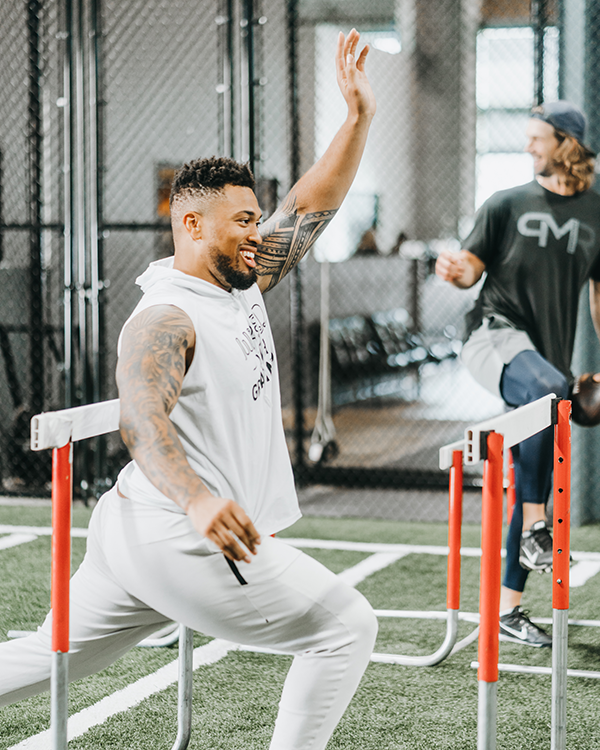 3. Flexibility (Stretching) and Dynamic Warm-Up
3. Flexibility (Stretching) and Dynamic Warm-Up
Stretching and a dynamic warm-up are two separate entities. Stretching is primarily used to gain more range of motion in muscle whereas a dynamic warm-up is intended to increase the core temperature of the muscles and to prepare the muscles, joints and nervous system for an upcoming physical event.
Before an NFL game, you normally will see players going through a stretching routine that is followed by a dynamic warm-up. The key muscles athletes target are the hip flexors, hamstring and calves (to name a few). The dynamic warm-up consists of a series of gradual movement drills such as jogging, high knees running, backpedaling, shuffles, carioca and other various change-of-direction movements performed for a length of 10-to-15 yards.
Proper planning built into the practice/pregame routine, consisting of stretching followed by a dynamic warm-up, will help maximize performance.
Read more about What Should My Warmup Look Like on the Spooner blog!
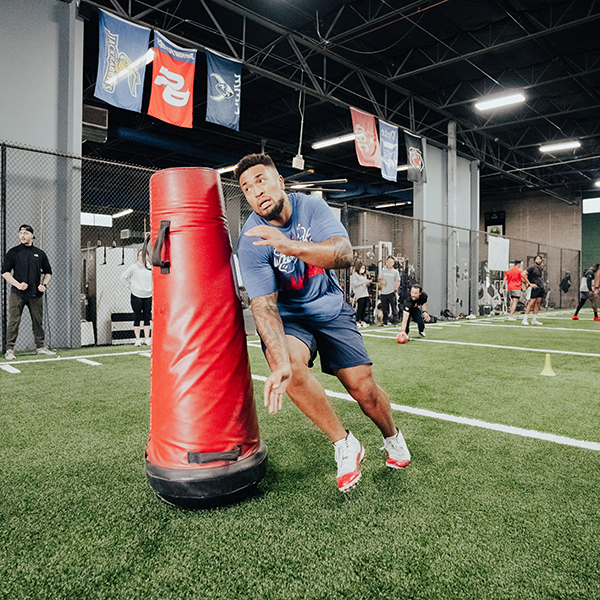 4. Football Specific Conditioning (Running/Agility Drills)
4. Football Specific Conditioning (Running/Agility Drills)
NFL players prepare for the season with five months of specific and progressive running and agility drills. This is why you can see some of the most exciting athletic feats on this planet every Sunday!
For the young athlete/weekend warrior, practicing change-of-direction running and agility drills that mimic the specific position requirements during a game is important for becoming perfectly football fit.
As a reference, a typical NFL game averages only 11 minutes of live action. That doesn’t sound like a lot. But in one game, a defensive back on average will run about 1,400 yards, which get broken up in to 50 to 80 plays that last four to five seconds. The average amount of yardage per play is 17 yards of running. (Lineman run on average between 400 to 600 yards in a game.) Therefore, in order to improve performance, running and agility drills must match the requirements of the specific positions.
Read more about What Should My Warmup Look Like for Runners on the Spooner blog!
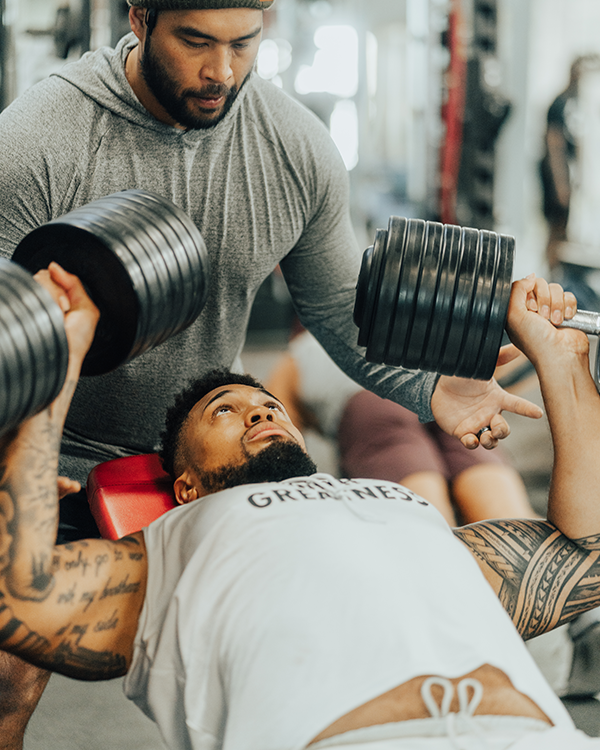 5. Participate in a Strength/Power Development Program
5. Participate in a Strength/Power Development Program
NFL players are some of the most powerful athletes in the world! That’s why the NFL is so popular. The players spend months training their bodies to improve their strength and power and become bigger, faster and stronger.
For the young athlete/weekend warrior, developing your leg, hip, core and upper body muscles is imperative. During the season, it is important to understand that you CAN IMPROVE strength and power. This can be accomplished by a “wave-cycle” program (popularized by world renown strength coach, Daniel Baker, from Australia). This program simply involves changing the volume (total amount of reps and sets in a workout) and the intensity (the amount of resistance/effort) on a weekly or biweekly basis.
For example, a week or more of a strength training program at three sets of 10 repetitions (below 70 percent of one rep max of that particular exercise) maybe followed by a week or more of higher intensity training (four sets of four reps at 90 percent of one rep max) with a lower volume of total exercises in that daily program than the previous phase. Then this phase could be followed up by a power phase (three to four sets of six reps at 70 to 80 percent of one rep max).
Furthermore, depending where you are in the season, as far as length of games, injuries, weather, etc., the program might switch to light intensity, high rep for a week or so. This wave-like program will avoid plateaus with its strength and power and will keep the workouts interesting.
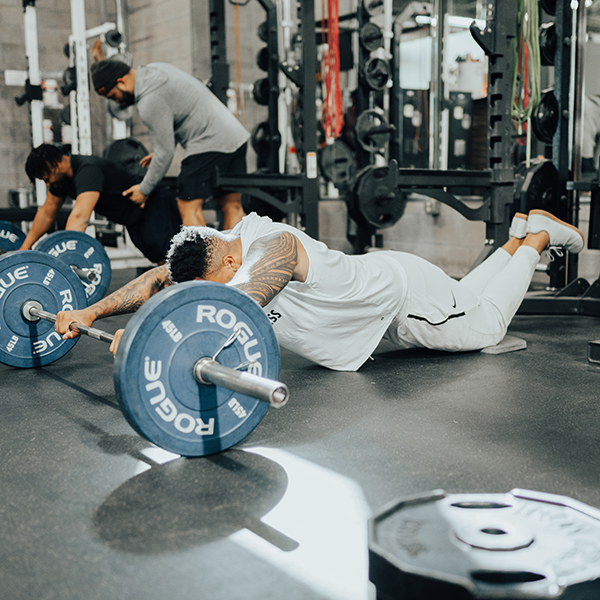 6. Core Strength
6. Core Strength
Even though many of today’s NFL stars have “six-pack” abs, it is the deeper core muscles that exist under those abs that link their upper-body power with their lower-body torque.
A quick test to see if the athlete’s deep core muscles are ready and strong is to do the Plank Test. To do this test, have athletes get into a pushup position while on their toes. Their upper body rests on their forearms, not their hands. Have them attempt to hold a straight position with their entire body without letting the lower back arch for one continuous minute.
7. Proper Nutrition
To be the best and to stay on top, football players must “fuel” their bodies.
We go into great detail about athletic nutrition in the article Fueling Your Movement and Why It Matters, but here are a few tips:
Pre-game meal: Pre-game meals help keep the player from feeling hungry during the game and should be easy to digest so the stomach has time to empty out before getting on the field. Plan out meals that are composed of mostly carbohydrates with a moderate amount of protein. Keep fat and fiber intake low. A beverage high is carbohydrates is useful shortly before or during a game.
Post-game meal: Post-game meals move to focus on healthy portions of fruits and vegetables, lean protein, whole grains and normal levels of fat and fiber. Try to focus on healthier fats such as monounsaturated or polyunsaturated fatty acids.
Most importantly, good nutrition shouldn’t only focus around game days. Successful athletes maintain healthy and substantial diets year round to stay football fit.
8. Hydration
Football players have unique hydration needs due to their exposure to extreme heat while wearing heavy equipment that covers their entire bodies.
Every NFL team employs a staff of certified athletic trainers who are accredited by the National Athletic Trainers Association (N.A.T.A.). These top notch athletic trainers constantly monitor the weather conditions, length and time of day at the event as well as the hydration levels of each player before, during and afterward.
Here are some of the recommendations concerning hydration from the N.A.T.A.
- Hydrate before, during, and after practice/games
- Two to three hours pre-event, drink 17 to 20 fluid ounces of water or sports drink
- Ten to 20 minutes pre-event, drink seven to 10 fluid ounces of water or sports drink
- During the exercise event, drink seven to 10 fluid ounces of water or sports drink every 10 to 20 minutes in a shaded area with helmets removed
- Avoid soda pops or carbonated drinks of any kind
- Post exercise, aim to correct any fluid loss accumulated during the event. This ideally should be completed within two hours of the event. The hydration should contain water to restore hydration status, carbohydrates to replenish glycogen stores and electrolytes to speed the re-hydration process
Read more about the Effects of Dehydration on Athletic Performance on the Spooner blog!
9. Rest Periods/Sleep
NFL teams will “taper down” the intensity and length of practices as gameday approaches. Also proper rest and sleep is important to re-charge their bodies to allow for peak performance. We dive into the details about the role sleep plays in athletes in 3 Ways Sleep Plays A Role In Recovery.
Many athletes, including U.S. Olympic teams, try to get 9-11 hours a sleep a night so they can perform at their best. They also spend time at night creating the perfect environment to fall asleep and stay asleep in. This includes creating a cool room, turning off electronics, and making the room dark (but not necessarily pitch black). Each sleep strategy is unique to each athlete.
10. Mental Preparation
I have been blessed to have worked with some of the best players the NFL has seen, from Terrelle Davis to Kurt Warner to Donovan McNabb to Larry Fitzgerald to Darrelle Revis. What they all had in common, besides being genetically gifted, was a “deep burning” passion for this game!
According to sports psychology consultant Derin McMains: “It is important to first ask yourself why you are competing. Also ask yourself, what do you want your teammates and coaches to say about you at the end of the season. What type of legacy do you want to leave for this year?
“Determining what you want your legacy to be at the end of the season will tell you what you need to do today. Determining your legacy will lead you to discovering your true PASSION for why you compete. And PASSION will be the motive that will drive you past your competitors. PASSION will be at the center of what continues to push you when your body is telling you to quit. PASSION is what continues to tell you that ‘you can,’ when others say ‘you can’t.’ PASSION gives you purpose. And athletes that compete with a deeper purpose perform at a higher level. Write down your legacy today and connect with your PASSION to take your game to the next level.”
Learn more about Sports Medicine at Spooner Physical Therapy. Ready to schedule an appointment? Schedule an appointment or complimentary movement screen with a Spooner physical therapist at one of our locations throughout the valley.

